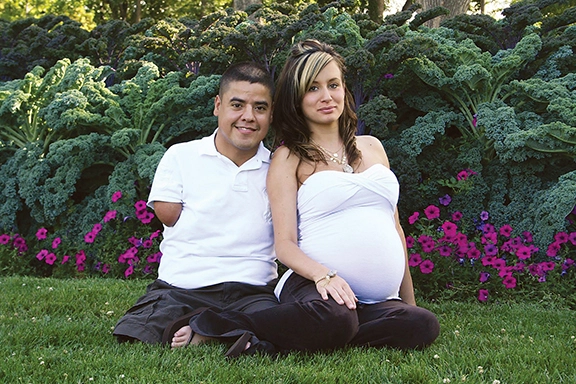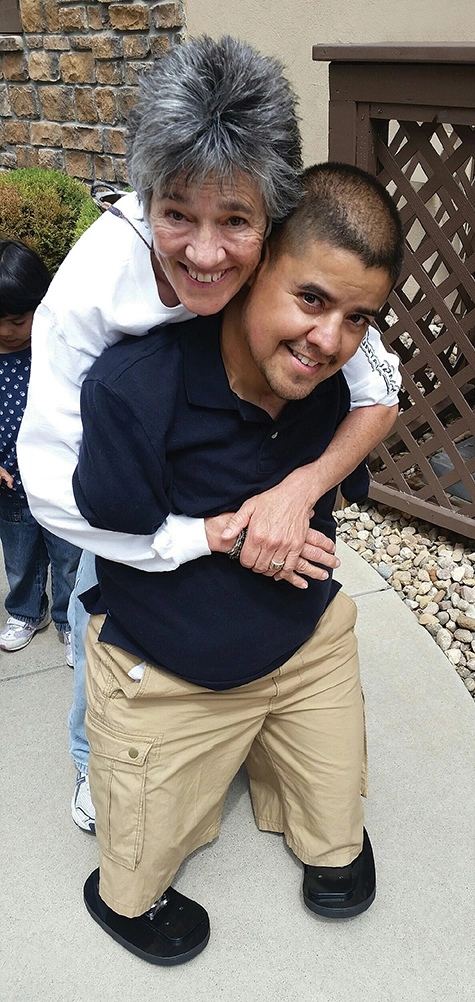By Scott Mcnutt

When he was 22 years old, after a horrific accident robbed him of his arms and legs, Manuel Salazar wondered why he was alive. Today, at 35, he wonders what he will accomplish next.
In 2003, Salazar was working a construction job in South Carolina when a crane hit a power line and sent 115,000 volts of electricity surging through his body—twice. Rescuers could not reach him for several minutes because the power could not be shut off. Much of his body was badly burned, and his arms and legs were so charred that they had to be amputated. His recovery and rehabilitation would take years.
Still, Salazar was alive, although he couldn’t understand why. He was dependent on others for his every need. His wife, unable to cope with the situation, left him within a year and took her children from a previous marriage with her. Salazar had a close relationship with the children, and the loss of his family was a bitter blow.
He was depressed and doubted that he could go on. However, one day, while attending an amputee support group, Salazar’s attitude suddenly changed. Others in the group were talking about things they wanted to do. But they always seemed to be waiting until later to do them.
“It made me realize that life was too short to just give up,” he says. “At that point, I figured I could continue living life and go figure out new ways of doing things that I still wanted to do.”
Salazar began his recuperation at a burn center in Augusta, Georgia, but he moved to Colorado for rehabilitation at the Denver Clinic for Extremities at Risk. His caregiver for many years, CoCo Saltzgiver, helped Salazar discover ways to do what he wanted to do.

“What I love about Manuel is that he didn’t let his accident define him,” Saltzgiver says.
She supported his desire to try new things, and if Salazar became discouraged, she would tell him, “Never say you can’t until you try.”
Salazar had been told he would never walk again. Nevertheless, with Saltzgiver’s encouragement, he tried. Proving doubters wrong, Salazar learned to walk on short prostheses called “stubbies,” sometimes walking up to three miles a day.
Strangers who saw Salazar walking in a mall or a gym might stare at first. But after he spoke to them, they would come away inspired.
“People would come up, and he would tell them what happened. And they would say, ‘All that, and you are still walking? That’s awesome,’” Saltzgiver says.
Salazar’s desire to try new endeavors went beyond accomplishing activities of daily living. So he and Saltzgiver developed a list of adventures to attempt. On it were water skiing, snow skiing, and skydiving. Together, they accomplished each of those goals, although Saltzgiver balked a bit at skydiving.
“I said, ‘What? You want to try skydiving?’” Saltzgiver recalls.
Salazar slyly reminded her that she was the one who had told him, “Never say I can’t until I try.”
For him, skydiving may have been the most fun item on their list. While they were freefalling, their skydiving partners maneuvered the friends close enough that Saltzgiver could see that Salazar “was grinning from ear to ear.”
Salazar has also fulfilled another more personal goal: He remarried and had children.

Image courtesy of CoCo Saltzgiver.
That is not to say that marriage was just a check mark on a list. “I am lucky to have a great woman,” he says of his wife, Angela.
The couple has three children and plans to have a fourth. Salazar now works on cars, attends car shows, gives inspirational talks, and works out with a trainer at 24 Hour Fitness, which recently honored him for his inspiration.
Although Saltzgiver is no longer Salazar’s caregiver, the two have created a second list of adventures to undertake. Traveling to places like London and Paris is at the top of the list for the once-bedridden quadruple amputee.
Salazar no longer wonders why he is alive. Now he lives to take care of his family, take on new challenges, and take his inspiring story to others in need.
And soon, Salazar’s journey from depression to surviving to thriving may find a larger audience to inspire. Independent filmmaker Martin McGuire spent years filming Salazar’s progress, capturing his grueling recovery and rehabilitation, his and Saltzgiver’s friendship, and Salazar’s inspiration to others. The film is now in post-production.
The filmmaker hopes that anyone who is struggling will be able to see the movie’s characters work their way through their lives against all odds and say, “If they can do it, I can do it!”
“We are hoping our film gives hope, inspiration, and a sense of permission to go after life with all you have and to enjoy it along the way,” McGuire explains. “That each person can know that they have purpose and meaning. If their old ways aren’t working any more, they can look to do things in a new way—they can set and reach goals big and small.”
The film, titled Never Say I Can’t: The Manuel Salazar Story is scheduled for release in March 2016.
For more information, visit www.manuelsalazarstory.blogspot.com or www.facebook.com/ManuelSalazarStory/?fref=ts.



